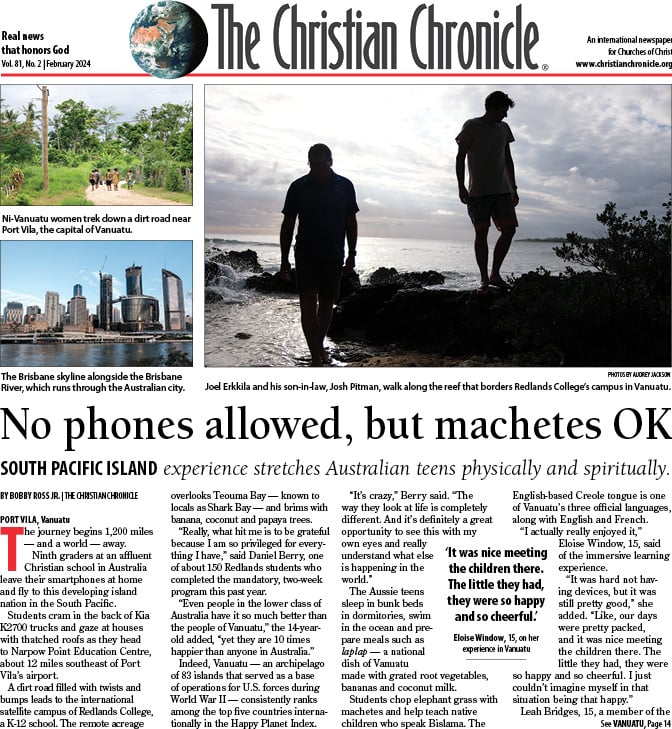Dialogue: A conversation with Geoffrey Ellis
Geoffrey Ellis’ life is woven into the fabric of the Canadian church.
He headed south to attend Abilene Christian College in Texas in the 1950s and earned bachelor’s and master’s degrees.
“Geoff Ellis’ decision to return home and serve Christ in his native Ontario began a life of providing mature leadership for Churches of Christ throughout Canada,” said Jerry Rushford, director of church relations at Pepperdine University in Malibu, Calif.
Ellis began his work in Canada with Great Lakes Christian College in Beamsville, Ontario. He served first as a teacher and later as president, a position he held for 23 years. Ellis also served as evangelist with the Waterloo, Ontario, church from 1984 to 1998.
Ellis led Gospel Herald surveys of the Churches of Christ in Canada in 1981, 1991 and 2001, which were used to track growth and encourage outreach.
He holds a doctor of ministry degree from ACU and serves as chairman of the Canadian Churches of Christ Historical Society in Waterloo.
In 1996 he helped reactivate Great Lakes Bible College in Waterloo, where he still teaches.
Geoff and Doreen, his wife of 57 years, live in Waterloo and attend the Waterloo church. They have three children, eight grandchildren and five great-grandchildren. In his spare time Geoff enjoys hunting and gardening, and, of course, watching hockey.
How and when did Churches of Christ begin in Canada?
The beginnings of Churches of Christ in Canada can be traced to Prince Edward Island in about 1810 when immigrants from Scotland holding Haldane and Scotch Baptist values began to pursue biblical church life.
In Ontario (“Upper Canada”) the first to seek a Restorationist path were Baptists who moved in 1820 into the wilderness north of York (now Toronto), at Norval in Esquesing Township, to establish both a settlement and a church.
For the next 50 years, leadership for the movement in Canada was drawn largely from Great Britain, but the ideas of Campbell and Stone were spreading.
In 1881, the first congregation in the newly opening prairies was planted in Portage La Prairie, Manitoba. Westward migration from Ontario helped swell the church in that region. In the first decade of the 20th century, members of the church from England formed a congregation in Vancouver.
Give a snapshot of Churches of Christ in Canada.
As Canada’s modest population of 33.2 million is thinly spread across a vast land, sectionalism is a feature both of community and congregational life — taxing fellowship.
Of some 150 congregations total, five congregations are located in the Maritime Provinces of New Brunswick and Nova Scotia. (There are no congregations presently in Prince Edward Island or Newfoundland.) There are six churches in Quebec, three French speaking, one Spanish speaking, and two multilingual.
In Ontario there are 75 congregations, including in the Toronto region, one congregation with 35 ethnic groups worshiping together and another with 25. In the western provinces of Manitoba, Saskatchewan and Alberta there are 35 churches. And in British Columbia there are 26.
Canada has three northern “territories” — Yukon, Northwest Territories, and Nunavut. Among these there is one congregation, in Yellowknife (Northwest Territories). The average size of a Canadian congregation is 45. One in three has elders, and four of five have preachers.
What are some distinguishing marks of the Canadian church?
Not surprisingly, Canadian members reflect features of the community at large: conservative, low-key, peaceable even to the point of passivity, and respectful of law and order.
Understandably, Canadian Churches of Christ are not engaged in a counterpart to the U.S. “religious right” movement. The “issues” that challenge our churches south of the border confront Canadian congregations as well, but there is a tendency to ignore rather than debate those who accept what some consider divergent.
The slow growth of the movement in Canada has resulted in a high interrelationship through family ties. This has created a strong support system for those on the inside, but it sometimes may make it difficult for outsiders to “feel at home.”
Historically, Canadian Christians have been active in foreign missions. Notables include J. C. Bailey in India and Joe Cannon in Japan and Papua New Guinea. Young Canadian missionaries are working today in these latter two countries.
What has been the relationship with the U.S. church?
From 1880 on, Canada attracted the mission interest of a burgeoning church south of the border, and the movement quickly became continent-wide. Constant two-way cross-border movement by Christian families has strengthened the intermingling.
Canadian students attended Nashville Bible School at the beginning of the 20th century. To the present, training in the southern Christian colleges and universities has been consistently popular.
Traditionally, both workers and funding from the U.S. have been invested in the Canadian work. In the 1980s, one of every six preachers was fully supported by American churches, and one of every three preachers drew some of his support from this source.
Some noted American preachers have made Canada their lifetime work, including Jim Hawkins, Wayne Turner, Walter Hart and Max Craddock. Canadian congregations frequently look to American leaders for special programs and lectures.
Is Canada a mission lab?
The slow growth of Canadian Churches of Christ, historically at about a 10 percent rate of the comparative American growth, has prompted a long tradition of diagnosis.
Typically, the reasons given are: lack of faith, lack of effort and failure to apply effectively the tried and true methods that produced success in the U.S. What have been ignored on both sides of the border are the significant cultural differences that do exist between the two nations.
In America, the Restoration Movement found a parallel in social and political developments. In Canada, four out of five people forming the nation were loyal to the traditional churches of the old world.
The evangelical movement in Canada has reached only 7 percent to 8 percent of the population, and this steadily for the past 150 years. A “people movement” was experienced in the former but not in the latter.
But people movements have been experienced infrequently by “our” efforts — exceptions, the U.S.A., India and Africa — a million members in 50 years in each!
Elsewhere, progress has been measured. Improved evangelistic success in Canada can result from careful analysis of the target communities and thoughtful approaches devised — an approach that bears repeating around the world.
What are hopeful signs of progress in Canada?
Religious nominalism in Canada has merged with a rampant secularism. The Canadian “establishment” is a-Christian if not anti-Christian. However, there are signs that growing spiritual deprivation is not acceptable. A new age of openness to the message of the King may be coming.
Both new people groups in Canada and migrant communities who experienced New Testament Christianity in their former settings may well be more open to the message.
After the low period of the ‘90s, there is a return to church planting in Canada, including Edmonton, Cambridge, Mississauga and Ottawa. Canadian churches are supporting the Strathmore Boulevard Church of Christ in Toronto and speaker Max Craddock in beaming “Key to the Kingdom” to televisions across the Dominion.
And young Canadians are training in Canada to evangelize Canada — at Western Christian College and Great Lakes Bible College where their training is “in context.”
-
FeedbackAs a Great Lakes Christian alumnus, I can say with certainty that Brother Ellis’ description of the church in Canada is spot on. However, I might add that it seems Canadian Christians attending our southern colleges and universities has sometimes resulted in a ‘brain drain.’ Gifted young men obtain their degrees and then are unable to find positions in Canadian churches. Inevitably, they are employed by US churches, further eroding the base of the Canadian church. I wonder if an emphasis on vocational missions is in order – especially in Prince Edward Island and Newfoundland. Perhaps graduates from our missions programs should seriously consider targeting the plentiful harvest to the North! The workers apparently are too few.Caleb J. MillerSunshine Church of ChristMinford, Ohio
USASeptember, 3 2009




What’s missing in the presentation I plan to make to council, in order to save the church, are archival pictures of either the church or any members of the Menzies family.
Any help you could offer would be appreciated.
Sincerely, Pat Farley (Heritage Halton Hills)
Canada